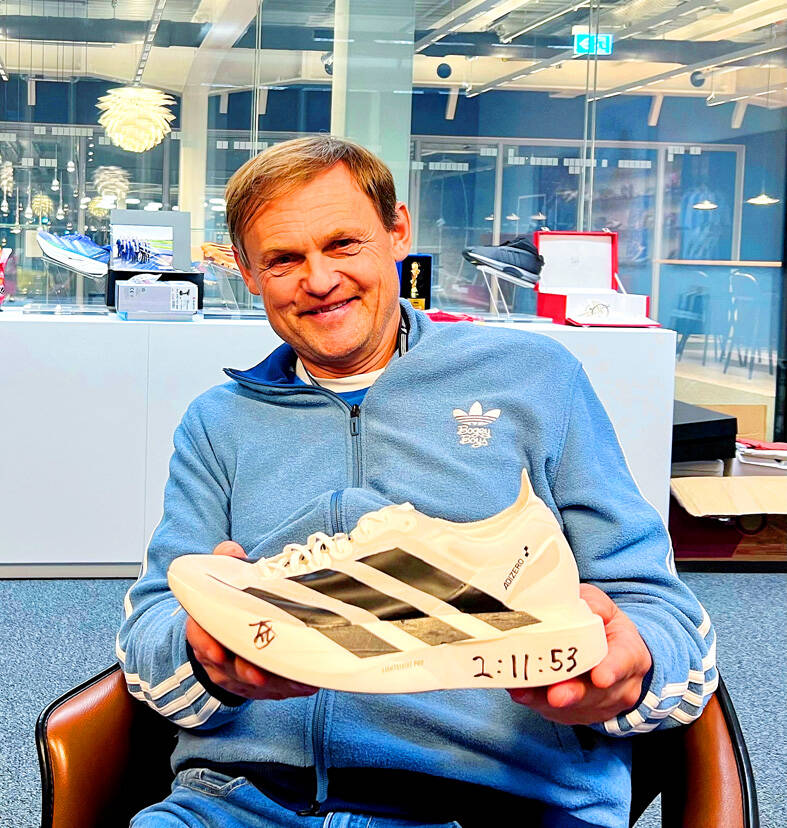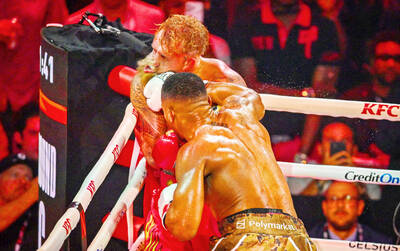A century after the 1924 Paris Olympic men’s marathon was won by Finn Albin Stenroos in 2 hours, 41.22 minutes, next year’s Games in the same city could feature the first official sub-two-hour time for the distance after this year saw more barriers smashed.
Kenya’s double Olympic champion Eliud Kipchoge, who dipped under two hours with his unofficial Ineos challenge run in 2019, dragged the record down to 2:01.09 last year, but in October his compatriot Kelvin Kiptum stunned the sport when the 23-year-old took more than half a minute off the great man’s mark to post 2:00.35 in Chicago to kick-start talk of when, rather than if, a legal sub-two would arrive.
That came two weeks after Ethiopia’s Tigst Assefa astonishingly took more than two minutes off the women’s record with 2:11.53 — a time that would have been the men’s world record until 1967.

Photo: Reuters
Talented and hard working though both champions are, the key component of their incredible times was unquestionably the latest developments in shoe technology that has made comparisons with earlier eras, even the past decade, largely meaningless.
Kipchoge’s performances opened the world’s eyes to the condensed foam, carbon-plated super shoes Nike claimed could increase running efficiency (the amount of oxygen consumed per minute) by 4 percent.
Soon, every major race start line was awash with the trademark dayglow Nike Vaporfly and Alphafly.
Although the sport’s governing body World Athletics tried belatedly to rein things in with their stack height regulations in 2020, the genie was out of the bottle and it did not take long for other companies to close the gap.
Assefa ran Chicago in a new Adizero Adios Pro Evo 1 shoe, retailing at just under US$500. It conforms to the 4cm height rule but, at 138g, weighs about 40 percent less than any previous Adidas racing shoe.
The latest theory around the shoes is that the carbon plates have only a limited effect and it is the “barely-there” weight, combined with the energy-return cushioning and “rockers,” that prevents the fatiguing impact of previous thin-soled “racing flats” and allows athletes to maintain their optimum speed for longer.
Adidas says its newest shoes are “enhanced with unique technology that challenges the boundaries of racing” and highlight a foot rocker that they claim triggers forward momentum and further enhances running economy.
Nike is not about to hand over the baton just yet, however, as Kiptum achieved his record in yet another prototype, the Alphafly 3, also worn by women’s Chicago champion Sifan Hassan, who took almost five minutes off her personal best with the second-fastest women’s time ever of 2:13.44.
It was a similar story in several athletics events at the 2021 Tokyo Olympics where a combination of a fast track and revolutionary spikes produced some jaw-dropping records.
Such is the sport’s seeming obsession with times rather than races — when did you last hear anyone discussing the time of the Epsom Derby horse race winner? — that the pressure to keep installing faster tracks and allowing ever more beneficial shoes shows no sign of abating.
The Paris Olympic athletics program will undoubtedly produce magical moments, but it is photographs of athletes posing by their world record time on the finish-line clock that usually claim the front pages.
Once attention turns to the roads, particularly Berlin in September, such has been the astonishing progress in recent years that anything other than the magical first legal sub-two-hour men’s victory is likely to be widely greeted with something of an “oh well, maybe next year” shrug.

LOW-GOAL SHOOT-OUT: Of the nine penalties in the shoot-out, only three went in, with Flamengo’s Samuel Lino, and Vitinha and Nuno Mendes of PSG netting Matvei Safonov on Wednesday made four straight penalty saves in a penalty shoot-out to help Paris Saint-Germain beat Flamengo in the Intercontinental Cup final and win a sixth trophy of the year. The Russian goalkeeper was thrown in the air by his teammates after his exploits in the shoot-out, which was won 2-1 by PSG after a 1-1 draw after extra-time. It completed a trophy-laden 12 months for the French team, who had already won the Trophee des Champions, Ligue 1, the Coupe de France, the UEFA Champions League and the UEFA Super Cup — also on penalties against Tottenham Hotspur in

LACKLUSTER FIGHT: At one stage, the referee lost patience with the two fighters, warning them in the fourth round that ‘the fans did not pay to see this crap’ Former world heavyweight champion Anthony Joshua on Friday knocked out YouTuber-turned-boxer Jake Paul in their controversial Netflix-backed bout in Miami. The fight at the Kaseya Center, which saw both men reportedly splitting a mammoth purse of US$184 million, had triggered alarm across boxing due to the gulf in physical size and class between Britain’s two-time former world champion Joshua and Paul, an Internet personality who has forged a lucrative career through a handful of novelty boxing contests. However, in the event, Joshua made hard work of defeating his vastly less accomplished opponent, before his superior size and power eventually told

Paris Saint-Germain (PSG) were ordered on Tuesday by a French labor court to pay their former forward Kylian Mbappe up to 61 million euros (US$71.6 million) in unpaid wages and bonuses. France captain Mbappe, who left PSG in June last year to join Real Madrid, had been claiming more than 260 million euros in total from his former club. PSG in turn had demanded Mbappe pay them 440 million euros. Mbappe, 26, also claimed the Qatari-owned reigning European champions had applied the wrong French legal classification to his contract, but that was rejected by the court. The labor court said

The Africa Cup of Nations (AFCON) would in future be held every four years instead of every two years, the Confederation of African Football (CAF) said on Saturday. The surprise decision was made at the body’s executive committee meeting in Rabat and announced at a news conference by CAF president Patrice Motsepe. The tournament, which brings in an estimated 80 percent of CAF’s revenue, has traditionally been held every two years since its inception in 1957. Yesterday marked the start of the 35th edition, hosted in Morocco with the home team taking on Comoros. Motsepe said the next AFCON finals,